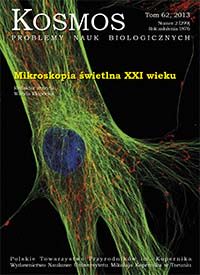Confocal microscopy and wide-field microscopy, two approaches to the live study
Abstract
Experiments on living organisms has always been one of the most important research in the life sciences. They allow direct observation of biological mechanisms occurring in different types of cells, microbes, or even in living animals. With the development of the various techniques for measuring fluorescence signals, using either wide field or confocal microscopy, are by now extremely well established and routine in many laboratories in the world. This resulted in development of live techniques in many areas of technology, starting with the various components (optical components, mechanical or electronic) by a conceptual approach to this type of research, ending with the creation of new fluorescent dyes which chemical properties are adjusted to the specific experiments. Thanks to the current available techniques, it is possible to observe and track even single molecules or study the interactions between proteins. This article introduces the basic techniques of live experiments using a wide field microscopy and confocal microscopy as well as the advantages and disadvantages of those two microscopes.Downloads
Download data is not yet available.
Downloads
Published
2017-12-09
Issue
Section
Articles



